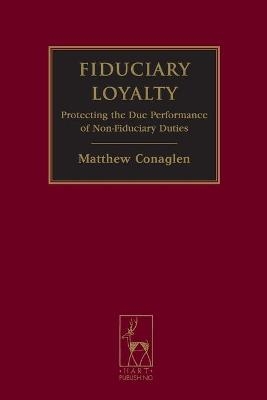
Fiduciary Loyalty
Hart Publishing (Verlag)
978-1-84946-214-3 (ISBN)
Fiduciary Loyalty presents a comprehensive analysis of the nature and function of fiduciary duties. The concept of loyalty, which lies at the heart of fiduciary doctrine, is a form of protection which is designed to enhance the likelihood of due performance of non-fiduciary duties, by seeking to avoid influences or temptations that may distract the fiduciary from providing such proper performance.
In developing this position, the book takes the novel approach of putting to one side the difficult question of when fiduciary duties arise in order to focus attention instead on what fiduciary duties do when they are owed. The issue of when fiduciary duties arise can then be returned to, and considered more profitably, once a clear view has emerged of the function that such duties perform.
The analysis advanced in the book has both practical and theoretical implications for understanding fiduciary doctrine. For example, it provides a sound conceptual footing for understanding the relationship between fiduciary and non-fiduciary duties, highlighting the practical importance of analysing both forms of duties carefully when considering fiduciary claims. Further, it explains a number of tenets within fiduciary doctrine, such as the proscriptive nature of fiduciary duties and the need to obtain the principal's fully informed consent in order to avoid fiduciary liability. Understanding the relationship between fiduciary and non-fiduciary duties also provides a solid foundation for addressing issues concerning compensatory remedies for their breach and potential defences such as contributory fault. The distinctive purpose that fiduciary duties serve also provides a firm theoretical basis for maintaining their separation from other forms of civil obligation, such as those that arise under the law of contracts and of torts.
Matthew Conaglen is a Reader in Equity and Trusts at the University of Cambridge and a Fellow of Trinity Hall. He is an Academic Member of the Chancery Bar Association and has practised as a barrister and solicitor in New Zealand. His PhD at Cambridge, on the nature and function of fiduciary duties, was awarded the Yorke Prize and he has published extensively in that area and in others.
1 Prologue
2 Points of Departure
I. Form of Analysis
II. Subject Matter of Analysis
A. Historical Analogies
B. Modern Approach
i. Genesis and Gestation
ii. Justification 1
3 Peculiarly Fiduciary Duties
I. Duty to Perform the Task Undertaken
II. Duties of Care and Skill
III. Conflict and Profit Principles
IV. Good Faith
V. Proper Purposes Doctrine
VI. Fiduciary Powers
VII. Duty to Act in Good Faith in the Principal's Best Interests
4 Fiduciary Loyalty
I. Introduction
II. Subsidiary Prophylactic Protection
A. Protective Function
B. Prophylaxis
C. Subsidiarity
III. Remedies
A. Rescission and Profit-Stripping
i. Rescission
ii. Accounts of Profits and Constructive Trusts
iii. Connection with Fiduciary Protection
B. Compensation for Loss
i. Availability
ii. Causation and Loss
iii. Connection with Fiduciary Protection
IV. Critics
5 Fiduciary Doctrine and Morality
I. General Observations
II. The Argument from History
III. The Profit Principle
A. Existence of the Profit Principle
B. Relationship to the Conflict Principle
IV. The Fair-Dealing Rule
A. The Self-Dealing Rule
B. The Fair-Dealing Rule
i. References to 'Fairness'
ii. Non-Critical Relevance of 'Fairness'
iii. Fairness as Evidence of Full Disclosure
iv. Relationship to the Self-Dealing Rule and Conflict Principle
V. The Corporate Opportunity Doctrine
6 Conflicts between Inconsistent Duties
I. Origins
II. Content and Function
A. Potential Conflicts
B. Actual Conflicts
C. Inhibition
i. Pattern of Liability
ii. Function
III. Remedies
A. Stopping Further Action
B. Rescission of Resultant Transaction
C. Forfeiture of Fees and Other Profits
i. Fees Paid by the Non-claimant Principal
ii. Fees Paid by the Claimant Principal
D. Equitable Compensation
i. Availability and Function
ii. Identifying Loss
iii. Contributory Fault
7 Implications
I. Scope of Fiduciary Duties
II. The Vital Nature of Non-fiduciary Duties
A. Consequence of the Protective Function
B. Potential Counter-examples
i. Preventing Circumvention of Fiduciary Protection
ii. Solicitors Cases
iii. Negotiations towards Joint Ventures
iv. Bare Trusts
III. Proscriptive Duties
IV. Authorisation
V. Critiques of Fiduciary Doctrine
8 Conceptual Affinities
I. Contract and Fiduciary Doctrine
II. Torts and Fiduciary Doctrine
A. Fiduciary Doctrine and Negligence
B. Surrogacy for Tort Law Generally
i. Cause of Action Surrogacy
ii. Civil Wrongs
III. Undue Influence and Confidence
A. Undue Influence
B. Confidence
9 The Incidence of Fiduciary Duties
I. Academic Commentators
A. Acting on Behalf of Another
B. Discretion and Power
C. Reasonable Expectations
D. Limited Access
II. Turning Theory into Practice
A. Judicial Applications
B. Relevant Considerations
10 Epilogue
| Erscheint lt. Verlag | 25.8.2011 |
|---|---|
| Verlagsort | Oxford |
| Sprache | englisch |
| Maße | 156 x 234 mm |
| Gewicht | 467 g |
| Themenwelt | Recht / Steuern ► EU / Internationales Recht |
| Recht / Steuern ► Privatrecht / Bürgerliches Recht | |
| Recht / Steuern ► Wirtschaftsrecht ► Gesellschaftsrecht | |
| ISBN-10 | 1-84946-214-3 / 1849462143 |
| ISBN-13 | 978-1-84946-214-3 / 9781849462143 |
| Zustand | Neuware |
| Haben Sie eine Frage zum Produkt? |
aus dem Bereich


